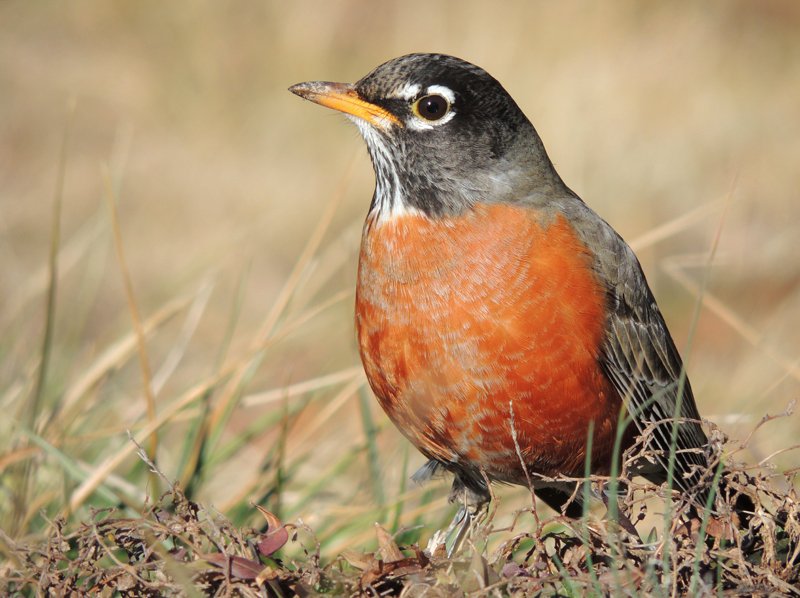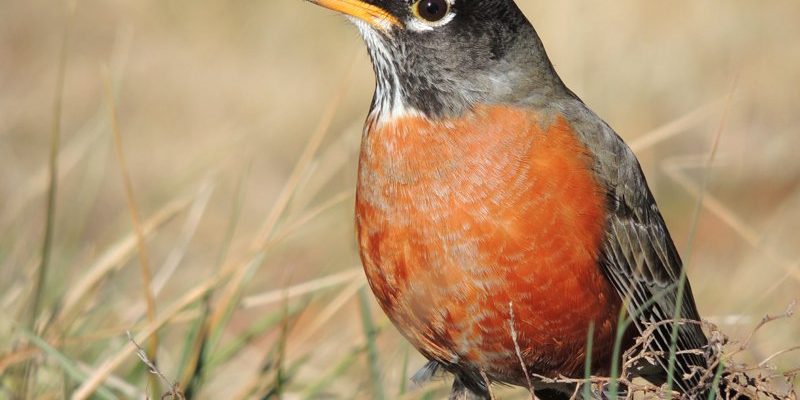
The American Robin is one of the most recognizable birds in North America. With its vibrant red-orange breast and cheerful song, this bird often serves as a harbinger of spring. Picture this: as winter thaws and the days grow longer, robins return, fluttering around your yard like a joyful reminder that warmer days are ahead. They are more than just pretty faces, though; these birds are fascinating in their behaviors and habits.
Robins are not just any bird; they have a special place in our hearts and in many ecosystems. You might be wondering what makes them so interesting, and how they fit into the big picture of wildlife. From their nesting habits to their diet, there’s much to uncover about these delightful creatures. If you take a moment to observe them, you’ll see that they’re not just singing; they are engaging with their environment in remarkable ways.
Physical Characteristics
The American Robin is a medium-sized bird, typically around 9 to 11 inches in length. Their most striking feature is, of course, their brightly colored red-orange breast, which contrasts beautifully with their darker grayish-brown back and wings. This coloration not only makes them stand out against the green of your garden but also serves as a form of camouflage when they are resting among leaves and branches. Their round bodies and long legs give them a characteristic bobbing motion as they hop across lawns.
Another notable characteristic of the American Robin is its yellow bill, which becomes particularly vivid during the breeding season. This feature helps in attracting mates, especially when paired with their beautiful songs. You might see them wading in your garden or on your lawn, looking for worms or other insects, their beady eyes scanning the ground intently.
Habitat and Distribution
American Robins are commonly found in a variety of habitats across North America, ranging from gardens and parks to forests and grasslands. They thrive in urban areas where they can readily find food and nesting sites. This adaptability makes them one of the most widespread birds on the continent. They prefer areas with low vegetation where they can easily forage for their favorite snacks—earthworms and berries.
Interestingly, these birds are migratory. In the fall, many robins fly south to warmer climates, seeking refuge from the cold winters in northern regions. By spring, they return, signaling the change of seasons with their familiar calls. This migration is a remarkable feat, as they can travel thousands of miles to find the right environment to thrive.
Diet and Feeding Habits
The diet of the American Robin is quite varied, allowing them to adapt to many environments. They primarily feast on earthworms, making them a common sight in backyards during the early morning or after rain. However, they also enjoy fruits and berries, which they hunt for high in trees or shrubs. You might have noticed them nibbling on your holly or mulberry bushes!
Robins are fond of foraging, which means they spend a lot of time searching for food on the ground. They use their keen eyesight to spot worms and insects. Sometimes, they’ll even use their beaks to turn over leaves or dig into the soil a bit to seek out a tasty treat. This constant search for food keeps them active and visible, so if you’re ever in your garden, keep an eye out for these bustling little creatures!
Breeding and Nesting
The breeding season for American Robins begins in spring, right around the time they return from migration. Females are responsible for building the nests, which are typically constructed in shrubs, trees, or even on ledges of buildings. Their nests are made of grass, mud, and twigs, forming a sturdy home for their young. It’s quite charming to think about how much care goes into creating a safe haven for their chicks.
Once the nest is built, the female lays between 3 to 5 eggs, which are usually a soft blue color. These eggs incubate for about two weeks before hatching, and soon after, the chicks emerge, hungry and chirping. The parents work hard to feed their young, bringing them worms and berries until they are ready to leave the nest—a process that can take around two weeks. Watching this nurturing behavior is a beautiful reminder of the cycles of life.
Behavior and Communication
American Robins are known for their melodious songs, which are often heard in the early morning and late afternoon. Their calls are a series of cheerful notes that sound like they’re singing out their name. This vocalization serves several purposes: attracting mates, defending territory, and communicating with fellow robins. If you listen closely, you may notice variations in their songs, each carrying a different meaning.
Beyond singing, robins exhibit fascinating social behaviors. They are often seen foraging in small groups, especially during migration or in the fall when they gather around abundant food sources. This social aspect of their behavior can be quite entertaining to watch. They communicate through body language too—like hopping eagerly when they spot a worm or puffing up their feathers when feeling threatened.
Fun Facts About American Robins
| Size: | 9 to 11 inches in length |
| Wingspan: | 12 to 16 inches |
| Weight: | 2.7 to 3 ounces |
| Diet: | Earthworms, fruits, and insects |
| Habitat: | Gardens, parks, forests, and urban areas |
| Nesting: | Built in trees or shrubs, made of grass and mud |
| Lifespan: | 2 to 6 years in the wild |
Conservation Status
The American Robin is currently listed as a species of least concern, meaning they are relatively stable in terms of population. They adapt well to human-altered environments, like cities and suburban areas. However, they still face challenges, including habitat loss and environmental pollution. It’s important for us to be mindful of these factors and to create friendly environments in our gardens to support local wildlife.
Simple actions, like planting native trees and shrubs or creating a water source, can significantly help robins and other birds thrive. Plus, watching them go about their day can be incredibly rewarding! Even small spaces can make a big difference in supporting these beautiful creatures.
The American Robin is more than just a bird; it embodies the spirit of change and renewal that comes with each season. Its song fills the air with a vibrant joy that signals the arrival of spring, while its presence connects us to nature in our own backyards. By understanding their habits, behaviors, and the challenges they face, we can better appreciate these delightful birds and contribute to their conservation.
FAQ
What is the American Robin’s primary diet?
The primary diet of the American Robin consists of earthworms, insects, and various fruits. They are skilled foragers, often seen searching through grass for worms after rain or high in trees for berries. This varied diet helps them adapt to different habitats and food availability through the seasons.
Do American Robins migrate?
Yes, American Robins are migratory birds. They usually migrate south for the winter, seeking warmer climates. They tend to return to their northern breeding grounds in the spring, which is when you’ll start hearing their cheerful songs again as they prepare to mate and raise their young.
How can I attract American Robins to my yard?
To attract American Robins, consider planting berry-producing shrubs or trees like holly or serviceberry. Providing a water source, such as a bird bath, can also make your yard more inviting. Keeping your lawn well-maintained will encourage them to forage for worms, adding to the chances of spotting them!
What are some common predators of the American Robin?
Common predators of the American Robin include hawks, cats, and snakes. Nesting robins need to stay vigilant to protect their eggs and chicks from these threats. Ensuring a safe environment with cover and natural barriers can help minimize predation risks for robins.
How long do American Robins live?
In the wild, American Robins typically live between 2 to 6 years. However, some individuals can live much longer, especially when conditions are ideal and they avoid predators and harsh weather. Like many birds, their lifespan can be influenced by various environmental factors.
What time of year do American Robins typically breed?
American Robins generally begin breeding in the spring, around March or April, depending on their location. This is when they return to their nesting sites and start building nests for their young, which adds to their visibility during this time as they seek mates and prepare for new life.
Can American Robins be found in urban areas?
Absolutely! American Robins are incredibly adaptable and often thrive in urban environments. They can often be seen in parks, gardens, and even on city streets, where they find plenty of food and nesting sites. Their presence in urban areas shows how well they can adjust to human-altered landscapes.
What sound does the American Robin make?
The American Robin’s song is a series of melodious phrases that can sound like cheerful chirps or whistles. This song serves multiple purposes, including attracting mates and signaling territory. They are one of the most vocal birds, especially during spring, where their song is a wonderful reminder of the season.
Do all American Robins have the same coloration?
While most American Robins exhibit the characteristic red-orange breast and grayish-brown back, there can be variations depending on factors like age, region, and breeding. Juvenile robins, for instance, have spotted breasts that gradually change to the familiar vibrant color as they mature.
What impact do American Robins have on the environment?
American Robins play a vital role in their ecosystems. By feeding on insects, they help control populations, and by spreading seeds from the fruits they eat, they contribute to plant growth and diversity. Their presence in the environment can signify healthy habitats, making them important indicators of ecosystem well-being.
How do American Robins nest?
American Robins build their nests using a mixture of materials like grass, mud, and twigs. They typically choose sheltered locations in trees, shrubs, or even human structures. Once the nest is complete, the female lays several blue eggs that she incubates until they hatch, showcasing their dedication to nurturing their young.

